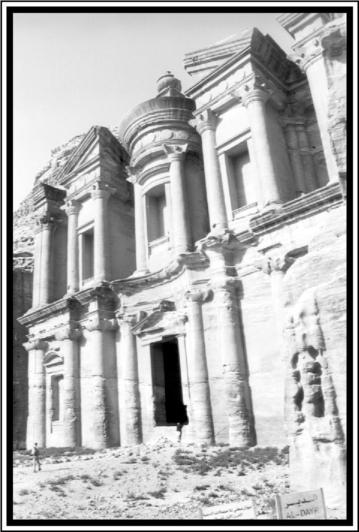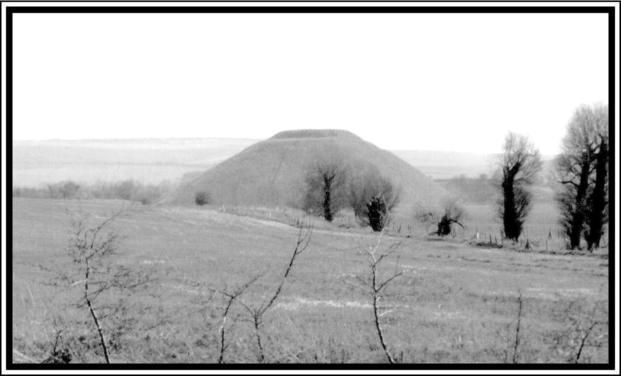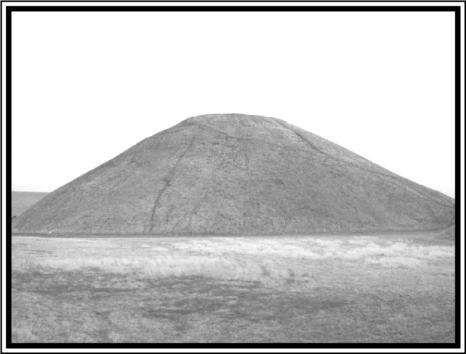Hidden History: Lost Civilizations, Secret Knowledge, and Ancient Mysteries (6 page)
Read Hidden History: Lost Civilizations, Secret Knowledge, and Ancient Mysteries Online
Authors: Brian Haughton
Tags: #Fringe Science, #Gnostic Dementia, #U.S.A., #Alternative History, #Amazon.com, #Retail, #Archaeology, #History

and threatens to flood the site of the
city. There was a catastrophic flood at
Petra in 1963, after which the government decided to construct a dam to
redirect the flood water. During building, the excavators were astonished
to discover that the Nabateans had
already built a dam, probably around
the second century B.C., to redirect the
flood water away from the entrance and
to the north, via an ingenious
system of tunnels, which eventually
diverted the water back into the heart
of the city for the use of the population.
The siq eventually opens out dramatically to reveal the best known and
most impressive of the monuments of
Petra, the classically influenced Treasury (El-Khazneh in Arabic). The name
Treasury originates from a Bedouin
legend that a pharaoh's treasure was
hidden inside a huge stone urn which
stands at the top of the structure. The Bedouins, believing the story,
would periodically fire their rifles at
the urn hoping to break it open and
recover the treasure. The many bullet
holes still visible on the urn are proof
of this practice. The well-preserved
facade of the Treasury, carved out of
the solid sandstone rock, is decorated
with beautiful columns and elaborate
sculptures showing Nabatean deities
and mythological characters, and
stands 131 feet high and about 88 feet
wide. The structure may have served
as a royal tomb, perhaps with the
king's burial place in the small chamber at the back, and also seems to have
been used as a temple, though to
which specific god or gods it was dedicated is not known. The exact date of
the Khazneh is not certain, though construction somewhere in the 1st century B.C. is the most likely.
One of the few remaining freestanding buildings at Petra is the huge
masonry-built Temple of Dushares,
also known mysteriously as Qasr alBint Firaun (The Castle of Pharaoh's
Daughter). This extensively restored
large yellow sandstone temple stands
upon a raised platform and has massive 75 feet high walls. The temple,
built sometime between 30 B.C. and A.D.
40, was dedicated to Dhushares, the
chief god of the Nabateans, and has the
largest facade of any building in Petra.
Inside, the building is separated into
three rooms, the middle room serving
as the sanctuary, or holy of holies.
Facing this structure is the Temple
of the Winged Lions, named after two
eroded lions carved on either side of
the doorway. This structure, the most
important Nabatean temple ever discovered, has been the subject of more
than 20 years of research and excavation by the American Expedition to
Petra. Apparently the temple was
dedicated to the pre-Islamic Arabian
fertility goddess Allat, who was one of
the three chief goddesses of Mecca.
Rather than a single building, the
Temple of the Winged Lions is really
a temple complex including workshops
and living areas. (One of the workshops even manufactured souvenirs!)
The temple is almost certainly the one
described in the Dead Sea Scrolls as
the Temple of Aphrodite at Petra. As
the site has produced such a huge
amount of excavated material the exact dates of its habitation are known.
The temple was founded in August A.D.
28 and was destroyed in the May A.D.
363 earthquake that brought down
many of the city's buildings.
The largest monument in Petra and
one of the most striking is El-Deir (the
Monastery), acquiring the name from
its use as a church during the Byzantine period (c. A.D. 330-A.D.1453). The
spectacularly situated structure, high
up on the mountain, is 164 feet wide
and 148 feet high, with its great doorway measuring around 26 feet in
height. The structure is carved, as
with the Treasury, into the side of a
cliff face. In fact, the Monastery is similar to a larger, rougher, weatherbeaten version of the more famous
Petra monument. Archaeologists believe that construction of El-Deir began during the reign of Nabatean king
Rabel II (A.D. 76-106), but was never
completed.
Petra was brought back to the center of public attention in 1989 with
the release of Indiana Jones and the
Last Crusade, starring Harrison Ford. In the film, it served as a secret
temple hidden for hundreds of years,
and the place where Harrison Ford finally locates the Holy Grail. It was in
the news again in 2005, when the Dalai
Lama led a host of Nobel Prize winners who, together with actor Richard
Gere, organized a two-day conference
at the rose red city entitled "A World
in Danger." The fortunately excellent
state of preservation of much of the
ancient city can be explained by the
fact that most of its structures have
been carved out of solid rock. However,
as with many ancient monuments, the
sandstone buildings at Petra are in
constant danger from excessive tourism, and the free-standing buildings in
particular are suffering from salt, water, and wind erosion. On December
6, 1985, Petra was recognized as a
World Heritage Site by UNESCO (the
United Nations Educational, Scientific, and Cultural Organization), and
for the past few years conservationists
have been at work on the monument
filling in the holes and cracks in the
stone with a specially designed mixture, as close as possible to the original sandstone of the 2,000-year-old
plus structures. Hopefully, one of the
world's most beautiful and spectacular ruined cities will be around for at
least another 2,000 years.

© Thanassis Vembos.
The Monastery at Petra.


Photograph by the author.
Silbury Hill, barely reaching the height of the surrounding hills.
Lying low in the Kennet valley in
Wiltshire, southern England, looms
the mysterious Silbury Hill, the largest man-made mound in Europe and
one of the biggest in the world. The
site stands amid the prehistoric sacred
landscape surrounding the present
day village of Avebury, and contains a
complex of Neolithic monuments, including an enormous henge (a roughly
circular flat area enclosed by a boundary earthwork), stone circles, stone
alignments, and burial chambers. The
imposing earthwork structure of
Silbury Hill stands at 128 feet high, its
flattened top is 98 feet across, and its
diameter at the base is 547 feet. The
huge 125 foot wide ditch that surrounds
Silbury was the source of much of the
material which makes up the mound,
an amazing 8,756,880 cubic feet of
chalk and soil. It has been estimated
that construction of the monument
would have taken the efforts of 1,500
to 2,000 men working for a year, 300
to 400 men working for more than five
years, or 60 to 80 men working for
more than 25 years. In all, an estimated 4 to 6 million man hours, though
some have suggested a figure as high
as 18 million hours. Because of its dimensions, Silbury has often been compared with the Great Pyramid in
Egypt, which is roughly contemporary with the huge English earthwork. According to a radiocarbon date recently
obtained from an antler pick fragment,
Silbury probably achieved its final
form between 2490 B.C. and 2340 B.C.
But what was the purpose of such a
massive undertaking of organization
and manpower?
There is at present no consensus
of opinion amongst archaeologists as
to how many building phases there
were at the huge earthwork at Silbury,
though we know its builders used tools
of stone, bone, wood, and antler in its
construction. The late Richard
Atkinson, who excavated the mound in
the late 1960s, hypothesized three
separate phases. In the first of
Atkinson's phases (Silbury I), dated to
around 2700 B.C., the earthwork consisted of a low gravel-built mound covered in alternating layers of chalk
rubble and turf, around 18 feet high
and about 115 feet across. Atkinson
believed that Silbury II was begun
about 200 years later, and consisted of
a much larger mound constructed over
the top of Silbury I. In this phase, the
earthwork had a diameter at its base
of about 246 feet, with a height of 66
feet. Silbury III was the hill's final
form, basically the earthwork we see
today. Atkinson thought that the structure of Silbury III had been built up in
tiers of chalk, only the upper two of
which are now visible on the monument. Each of these horizontal steps
was inclined inwards at an angle of 60
degrees, to provide the monument
with stability; the tiers were then
filled in with soil, probably from the
ditch at the base of the mound. Despite
Atkinson's three-phase theory, the latest evidence from surveys of parts of
Silbury has revealed the possibility of
there being only one construction
phase at the site. Only a complete survey of the whole monument will decide
this issue.
There have been three main excavations undertaken at Silbury Hill in
an attempt to fathom its mystery. The
first of these was carried out by the
Duke of Northumberland in 1776, who
hired a team of Cornish miners to dig
down from the top of the mound. However, they found nothing of note, and
as the workers did not fill in the shaft
properly after investigations were finished, their excavation led ultimately
to the partial collapse of the summit
of the mound in 2000. Antiquarian
Dean Merewether supervised the excavation of a tunnel from the side of
the hill to its core in 1849, but this shed
little light on the function of Silbury
Hill. Professor Richard Atkinson's
BBC-sponsored excavations of the
enigmatic earthwork, which took place
from 1968 to 1970, have been the most
comprehensive investigations of the
site to date. One of Atkinson's three
trenches followed Merewether's tunnel, but there were no sensational
finds. In fact, precious few artifacts at
all, no burials, and no clues to the function of the structure were found. However, from his work at the site,
Atkinson was able to arrive at his
theory about how the mound had been
constructed. Atkinson's excavations
also revealed considerable environmental evidence, including the presence of flying ants in the turf of
the building, which has been used
to suggest that construction of the
earthwork was begun in the month of
August, interpreted by some as coinciding with the Celtic Festival of
Lughnasadh, or Lammas. Even though Silbury was constructed 2,000 years
before, there is evidence of Celtic
culture in Britain.

Close-up of the mysterious Silbury Hill.
Photo by the author.
